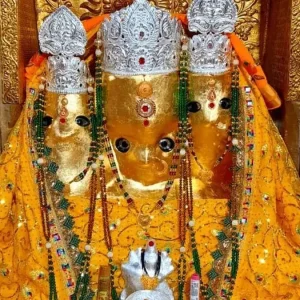
Jyotirlingas are sacred shrines of Lord Shiva; it is believed that Lord Shiva himself visited these places and hence they have a special place in the hearts of devotees. There are 12 of them in India.
Jyotirlinga means ‘column or pillar of light’. The ‘stambha’ symbol represents that there is no beginning or end.
When Lord Brahma and Lord Vishnu had an argument about who was the supreme god, Lord Shiva appeared as a column of light and asked each one to find the ends. Neither could do it. It is believed that the places where these columns of light fell is where the jyotirlingas are located.
Of the 12 jyotirlingas in India, the Mahakaleshwar Jyotirlinga is believed to be swayambhu i.e. originated on its own. Since kaal means ‘time’ and ‘death’, Mahakal i.e. Lord Shiva is called the Lord of Time and Death.
Where is the Mahakaleshwar Jyotirlinga located?
The temple is located in the historical city of Ujjain in Madhya Pradesh, India. It is situated on the banks of the holy river, Shipra.
Special features of Mahakaleshwar Temple
The Mahakaleshwar temple has been built in Maratha, Bhumija and Chalukya architectural styles. It has five levels, one of which is underground. There are images of Lord Shiva’s consort, Goddess Parvati (to the north), his sons, Ganesha (to the west) and Kartikeya (to the east) and his mount, Nandi (to the south).
On the second floor above the Mahakaleshwar linga is the Omkareshwara linga. Enshrined on the third floor of the temple is an image of Nagchandreshwar – with Lord Shiva and Parvati seated on a ten-hooded snake and surrounded by other statues.
It has a tall spire (shikhara) with intricate and beautiful carvings.
History of Mahakaleshwar Jyotirlinga
The mention of this temple in the Puranas, where it is stated that Prajapita Brahma built it, is proof of its ancient existence. The temple is believed to be built in the 6th century AD by Kumarasena, the son of a former king of Ujjain, Chandpradyot.
It was further reconstructed in the 12th century AD under King Udayaditya and King Naravarman. Later, the Maratha commander Ranoji Shinde under Peshwa Bajirao-I renovated this temple in the 18th century AD.
What is the story behind Mahakaleshwar Jyotirlinga?
Like all old structures and the stories that surround them, the legend behind Mahakaleshwar Jyotirlinga has many versions. One of them goes like this.
It is believed that King Chandrasena of Ujjain was a great devotee of Lord Shiva. While he was praying, a young boy, Shrikhar wished to pray along with him. However, he was not allowed to do so and was sent away to the outskirts of the city. There, he overheard a plot to attack Ujjain by enemy kings Ripudamana and Singhaditya with the help of a demon named Dushanan.
He began to pray to Lord Shiva to protect the city. Vridhi, a priest heard his prayers and also prayed to the Lord to save the city. In the meanwhile, the rival kings attacked Ujjain. They were almost successful in conquering the city when Lord Shiva came in his Mahakal form and saved them. From that day on, at the behest of his devotees, Lord Shiva lives on in this famous Ujjain temple in the form of a linga.
Interesting facts about Mahakaleshwar Jyotirlinga
- Since it is a self-originated linga, it derives power on its own. It does not require mantra shakti for power like the other lingas and moorthies (statues).
- It is the only jyotirlinga that faces south – dakshinamukhi. All the other jyotirlingas face east. This is because the direction of death is believed to be south. As Lord Shiva faces south, it symbolizes that he is master of death. In fact, people worship Mahakaleshwar to prevent untimely death – to enjoy a long life.
- Nagchadreshwar is opened to the public only one day in the year – on Nag Panchami day. It remains shut on all the other days.
- Bhasma aarti (offering with ashes) is a famous ritual here. As ash is pure, non-dual, imperishable and unchangeable, so is the Lord.
While devotees visit this temple throughout the year, it would be best to visit it in the winter months i.e. October to March. Visiting it during Mahashivratri (February 21st this year) would be the ultimate treat for any devotee!





